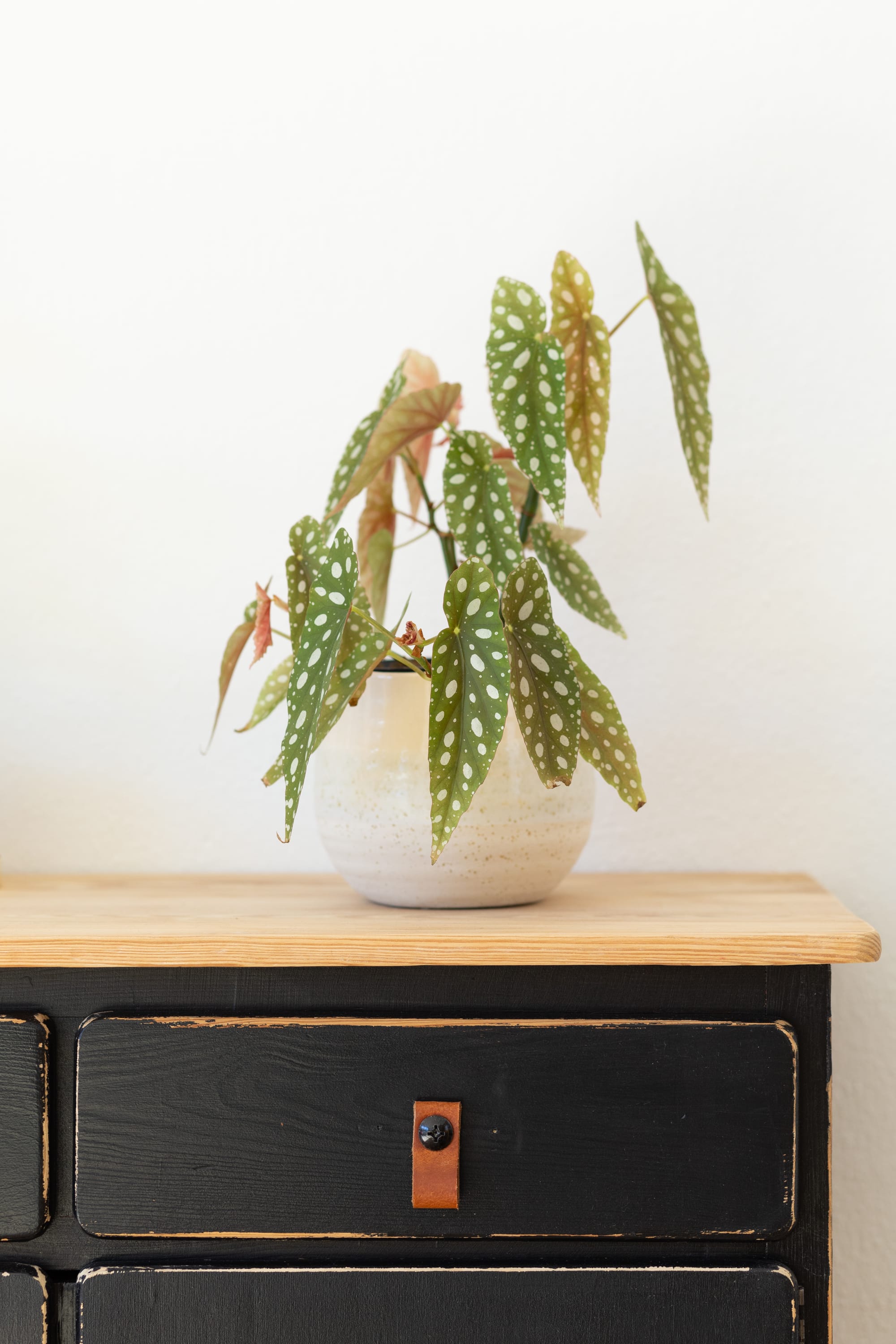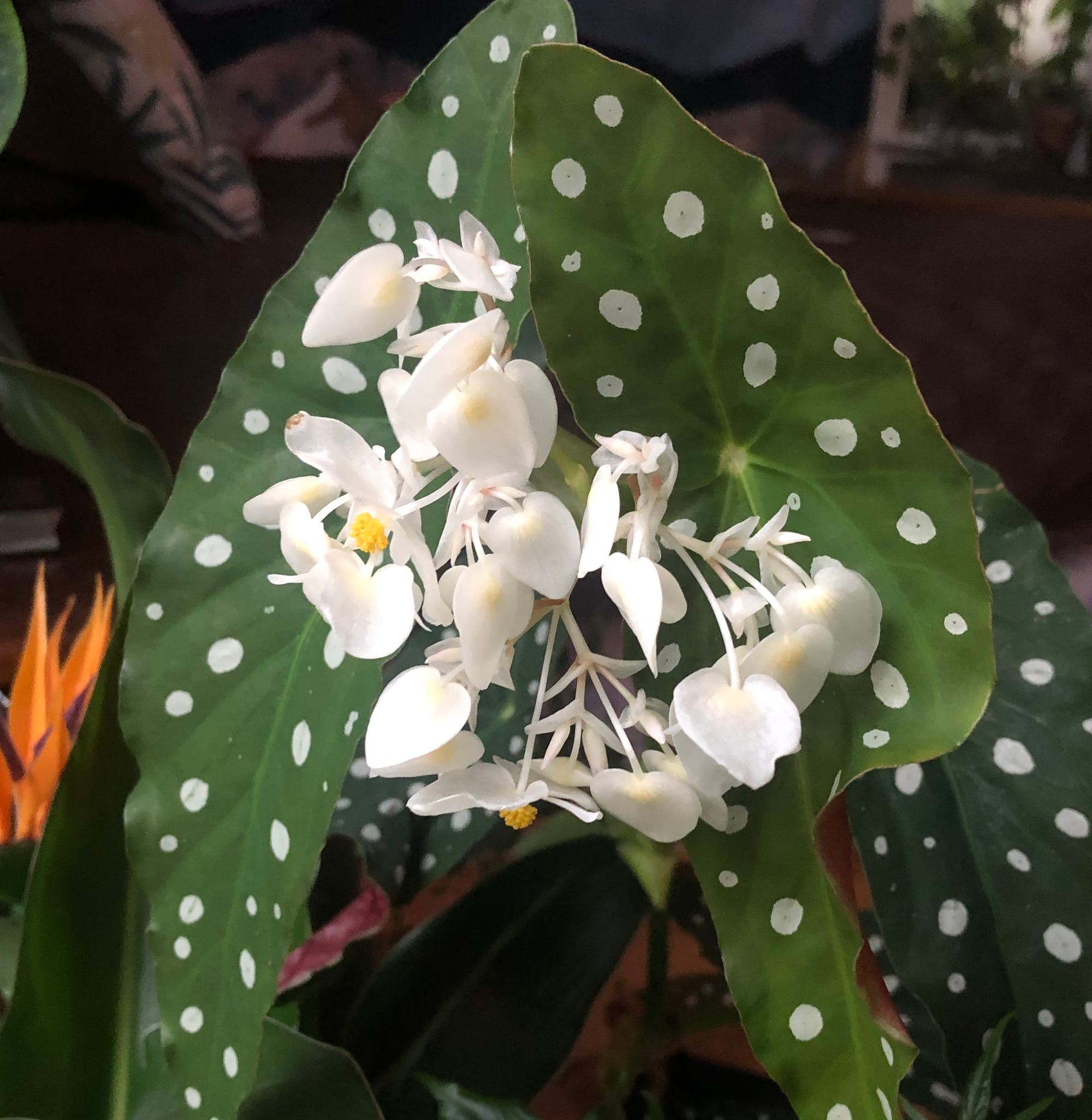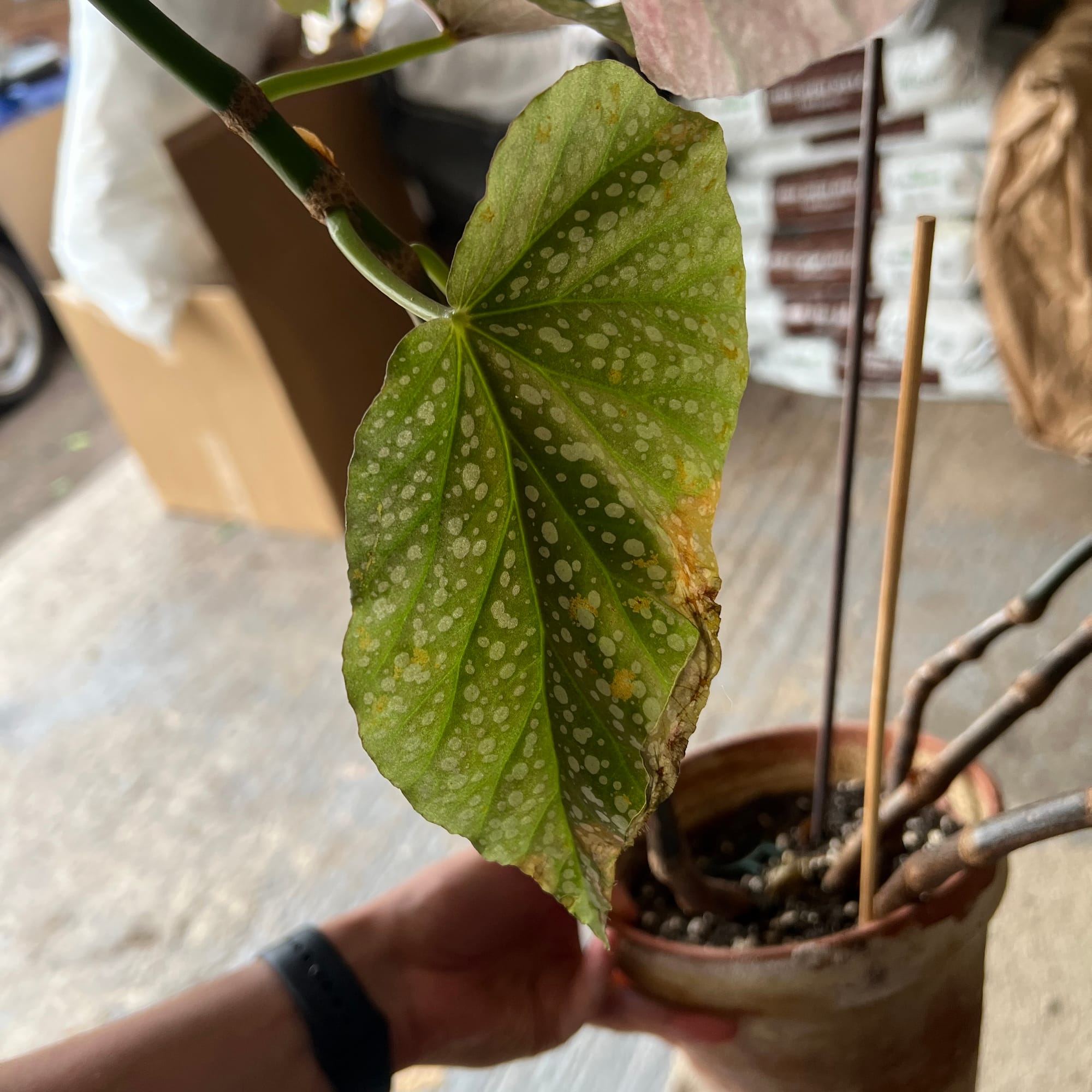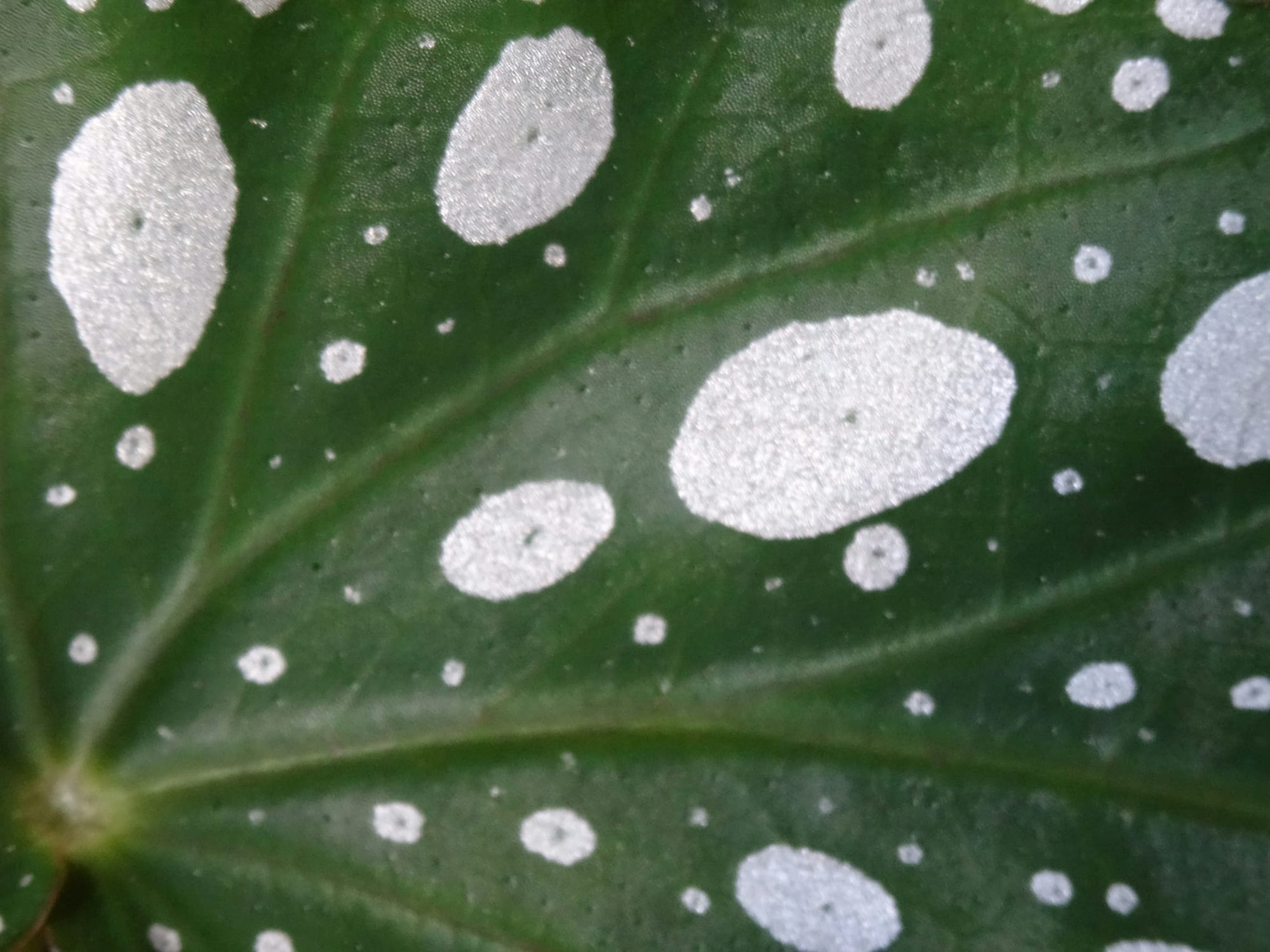
Begonia maculata 'Wightii'
Contents
- Top Tips
- Location, Water, Humidity & Fertilisation
- Common Issues
- Origins, Temperature, Propagation, Repotting & Toxicity.
Need the answer to a specific plant query? Book a 1-to-1 video call with THE HOUSEPLANT DOCTOR™, the website's friendly author, to overcome and address your niggling problem! Available on iMessage, WhatsApp, Facebook Messenger & more.
Top Tips & Info
- Care Difficulty - Easy
- Bright indirect light is best, avoiding prolonged exposure to the sun, especially in the spring and summer. A location that is too dark will cause the variegations (foliar patterns) to weaken, leaving you with just a green plant.
- Keep the soil evenly moist, allowing the top third to dry out in between hydrations. Avoid promoting droughts due to the heightened chance of yellowed or browned leaves and reduced growth.
- Fertilise using a 'Houseplant' labelled feed every four waters in the spring and summer, reducing this to every six in the colder months.
- White flowers will readily flourish from the summer onwards that can last up to six weeks. Swap the 'Houseplant' feed for a product high in potassium during this time to help prolong the blooms - 'Tomato' food is an excellent example.
- In spring, repot every three years with 'Houseplant' labelled compost. Water the plant 24hrs beforehand, to reduce the risk of damaging the root hairs. (Transplant Shock).
Location & Light - 🔸🔸
Provide bright, indirect light throughout the year to entice good quality growth. A sunny position that's too sharp will cause sun-scorch, along with crippling foliage and stunted growth. Locations that are too dark will cause the variegations to fade, as well as an increased chance of mould developing on the soil and root rot. The amount of light and current season of the year will directly govern the frequencies of waters per month. Specimens placed in darker areas must be kept on the drier side to life, whereas brighter locations will require more soil moisture to lubricate photosynthesis.
Water - 🔸🔸🔸
Allow the top third of the soil to dry in between waters, or a few inches for specimens that are too large to lift. Never allow standing water to accumulate beneath its pot as root rot is a common issue among gardeners. Under-watering symptoms include stunted growth, crispy brown patches forming on the leaves, yellow older leaves and wilting. Due to the Begonia's need for regular moisture, dehydration is a common problem that can be sped up by too much light or heat. Over-watering symptoms include mouldy soil, yellowing lower leaves, leaf blotches in brown, yellow or black, wilting and rotted stems/roots. Although it's under-watering that you'll need to manage, locations that are too dark may also cause soil-borne diseases such as root rot if it's kept too moist. Click here to learn more about identifying and addressing root rot.
Humidity - 🔸🔸
Average room humidity is more than enough to satisfy this plant. Never situate it within a few metres of an operating radiator due to the enriched chance of browning leaf-tips.
For those who tend to under-water, create a humidity tray to provide a moist environment and prolong the rate of drying-soil. Hose the foliage down from time to time to hydrate the leaves and keep the dust levels down.
Fertilisation - 🔸🔸
Fertilise every four waters during the growing period before reducing this to every six in the autumn & winter. Although an 'All-Purpose' fertiliser will still do the job, we'd recommend using a specific 'Houseplant' labelled fertiliser as it'll support the vital thirteen nutrients that this species will need to grow.
While the specimen is budding or in bloom, switch to a product high in potassium to prolong the duration of flowers. Good examples of this are a 'Poinsettia' or 'Tomato' labelled feed. Revert to the original fertiliser once the final inflorescence elapses.
 Your Polka Dot Begonia will produce a show of flowers from June onwards that'll last for around five weeks.
Your Polka Dot Begonia will produce a show of flowers from June onwards that'll last for around five weeks.
Common Issues with Polka Dot Begonia
Multiple older leaves turning yellow simultaneously are a clear sign of over-watering, usually caused by too little light, with other symptoms include mouldy or heavy soil, stunted growth and a rotten base. Although Begonia can do well in darker locations, the frequency of irrigations must be reduced to counteract the chance of root rot. People don't realise that a plant's root system needs access to oxygen too; when soil is watered, the air will travel upwards and out of the potting mix. A lack of accessible oxygen will cause them to subsequently breakdown over the oncoming days. Click on this link to learn more about root rot and how to address it.
Over time, your Begonia will become leggy after a while, which is normal behaviour for an establishing specimen. You can prune the specimen back by a third (to promote a more bushy appearance) and use the prunings as stem cuttings. Place their bottom halves in water for around eight weeks to root. Once the roots are over 3cm (1.2 inches), place them into the mother plant's pot to increase the number of leaves closer to the soil. Scroll down to 'Propagation' to learn more about this!
 Brown crispy blemishes on your Begonia maculata (Polka Dot Plant) is nothing to worry about as it's just a sign of the individual leaf ageing. THE HOUSEPLANT DOCTOR™recommends to keep this leaf on until it fully browns over, as the plant can take nutrients from the leaf to divert elsewhere.
Brown crispy blemishes on your Begonia maculata (Polka Dot Plant) is nothing to worry about as it's just a sign of the individual leaf ageing. THE HOUSEPLANT DOCTOR™recommends to keep this leaf on until it fully browns over, as the plant can take nutrients from the leaf to divert elsewhere.
Persistent droughts will result in crispy brown sections across its foliage. Allow the affected leaf to thoroughly brown over before removing it with a clean pair of scissors, as puncturing the soft tissue may cause bacterial diseases further down the line. Introduce a watering schedule or pebble tray to avoid the risk of dehydration in the future.

Why does my Begonia maculata have silver spots? Its stunning silver spots on its foliage (‘blister variegations’) have divided scientists for some time, but many believe it’s either to reduce predators from interacting with its foliage or reduces the risk of scorch from the sharp sunlight rays that may pierce through the forest canopy above. It's totally normal and isn't a sign of Powdery Mildew or root rot as some sources may suggest.
Severe dry air may cause browning leaf tips with yellow halos. Although this won't kill the plant, increase humidity to prevent new growth in adopting these symptoms. Either mist weekly while the heaters are on, or create a humidity tray to present a better growing condition.
Clean the leaves regularly. Although this isn't too much of an issue, a build-up of dust particles can clog up the plant's pores, causing lowered light capturing-efficiency. Rinse the topsides of the leaves down once a month to keep levels down and improve growing conditions.
 Powdery Mildew looks like a white slightly moist layer that covers your Begonia's leaf. Although this may look harmless, it could weaken the plant enough to kill it. THE HOUSEPLANT DOCTOR™ recommends wiping the foliage with a damp soapy cloth and use a fungicide from a local garden centre or online store. Improve the plant's environmental needs by increasing the light levels and reduce watering, too. This Mildew best grows in cold, damp areas with overly moist soils. The plant in the picture is not a Begonia maculata, but this is identical to how it would look on this plant. Spider Mites are small, near-transparent critters, that'll slowly extract the chlorophyll from of its leaves. Have a check under the foliage, most notably along the midrib, for small webs and gritty yellow bumps. Click here to read our article about the eradicating Spider Mites, along with some extra tips that you may not find elsewhere!
Powdery Mildew looks like a white slightly moist layer that covers your Begonia's leaf. Although this may look harmless, it could weaken the plant enough to kill it. THE HOUSEPLANT DOCTOR™ recommends wiping the foliage with a damp soapy cloth and use a fungicide from a local garden centre or online store. Improve the plant's environmental needs by increasing the light levels and reduce watering, too. This Mildew best grows in cold, damp areas with overly moist soils. The plant in the picture is not a Begonia maculata, but this is identical to how it would look on this plant. Spider Mites are small, near-transparent critters, that'll slowly extract the chlorophyll from of its leaves. Have a check under the foliage, most notably along the midrib, for small webs and gritty yellow bumps. Click here to read our article about the eradicating Spider Mites, along with some extra tips that you may not find elsewhere!
The browning of the sheath's casing shouldn't of be a concern, as it's a wholly natural process which affects all specimens across the world. Remove the brown section once it becomes dry and crispy, using your hands to peel back the browned tissue and improve its overall appearance.
A lack of flowers is caused by an insufficient dormancy period, where the temperatures are kept more or less the same over the year. Reduce the warmth by a couple of degrees over the autumn and winter months, along with fewer irrigations to ensure a well-spent dormancy. Supplement in the weeks leading up to potential buds (early summer) with a potassium-based fertiliser, for instance, tomato food.
Origins
The name, Begonia, was penned by Charles Plumier who was a French botanist in the seventeenth century. Carl Linnaeus adopted this name in 1753, honouring a well-respected governor of Haiti, named Michel Bégon. The genus has almost two thousand accepted species that have natural distributions across five continents, except Europe and Antarctica. The Polka Dot species, B. maculata, was described by Giuseppe Raddi in 1820, using the Latin word, macula, that refers to its spotted or speckled foliage.
 The Distribution of Begonia maculata (East Brazil)
The Distribution of Begonia maculata (East Brazil)
Temperature
12° - 26°C (54° - 80°F)
H1b (Hardiness Zone 12) - can be grown outdoors during the summer in a sheltered location with temperatures above 10℃ (50℉), but is fine to remain indoors, too. If you decide to bring this houseplant outdoors, don't allow it to endure more than an hour of direct sunlight a day as it may result in sun-scorch. Regularly keep an eye out for pests, especially when re-introducing it back indoors.
Spread
Up to 1m in height and 50cm in width, when maturity is reached in around four years. Similar to most cane-stemmed Begonia, B. maculata is considered a rapid-growing species that can grow up to 30cm per season.

A stunning example of a 3-4 year-old Begonia maculata (Polka Dot). Credit: Reddit (r/houseplants).
Pruning & Maintenance
Remove yellow or dying leaves, and plant debris to encourage better-growing conditions. While pruning, always use clean utensils or shears to reduce the chance of bacterial and fungal diseases. Never cut through yellowed tissue as this may cause further damage in the likes of diseases or bacterial infections. Remember to make clean incisions as too-damaged wounds may shock the plant, causing weakened growth and a decline in health.
Remove browned sheathes once they become dry and crispy, using your hands to peel it back for the improved appearance. Your Begonia will become leggy after a while, which is normal behaviour for an establishing specimen. You can prune the specimen's top third to promote a more bushy appearance, while using the prunings as stem cuttings to increase your plant numbers.
Propagation
Via Seed or Stem Cuttings.
Stem Cuttings via Water - (Easy)
- Choose the healthiest stems that are located in the top half of the foliage. This propagation method can be taken from spring to summer, with the stem being at least 10cm in length with two nodes (one for foliar development and the other for root growth). Although more nodes are acceptable, be sure only to submerge the bottom one to avoid inappropriate rooting elsewhere, which will be difficult to pot-up when it's time for soil placement. Be sure to use stems that HAVEN'T bloomed as energy-loss through the development of flowers will result in unsuccessful rooting.
- Cut 3cm below a node using a clean knife to reduce bacteria count. Remove the lower leaf and place the stems into a container of lukewarm water. Be sure to only submerge the bottom node into the water, with its foliage staying above the water line to prevent disease.
- Replace the water weekly, using lukewarm water to avert shocking the cutting with cold temperatures.
- Once the roots surpass 3cm ( 3.7 inches) in length, it's time to pot the specimen. Choose a potting mix - 'Houseplant' compost is best, but a multi-purpose compost with a splash of grit or perlite is acceptable, too.
- Use a 7cm (1 inch) pot that has suitable drainage holes - plastic or terracotta are both acceptable in this instance. Try not to over-pot the cuttings; blackleg occurs when the bottom wound becomes infected, typically caused by water-logging or a too-damaged wound.
- Fill the bottom third with soil and rest the plant on top. Pour the rest of the compost around the roots until it fills the top three-quarters of the pot. Gently tap the sides to remove any air pockets and to even out the soil structure. Never compact the compost for stability as it'll cause root rot by forcing the oxygen to the surface when irrigated. If it needs to be supported, use a cane!
- Avoid direct sunlight and offer good humidity by introducing a pebble tray to avert dehydration. Keep the soil evenly moist, allowing only the top inch to dry out in between waters. After a month of solid foliar growth, treat like an established specimen by following the care tips above!
Flowers
This species will bloom from mid-summer until early autumn, producing clusters of white flowers that can last up to six weeks. Although minimal work needs to be done for enticing a bloom, swap your fortnightly supplements for a potassium-based fertiliser in the summer months. Maintain fortnightly feeds until the final flower elapses in the autumn.
Repotting
Repot every three years in the spring, using a 'Houseplant' labelled compost and the next sized pot with adequate drainage. Hydrate the plant 24hrs before tinkering with the roots to prevent the risk of transplant shock. For those that are situated in a darker location, add a thin layer of small grit in the pot's base to improve drainage and downplay over-watering. Click here for a detailed step-by-step guide on transplantation, or via this link to learn about repotting with root rot.
Book a 1-to-1 video call with THE HOUSEPLANT DOCTOR™ if you'd like a personal guide to repotting your houseplant. This will include recommending the right branded-compost and pot size, followed by a live video call whilst you transplant the specimen for step-by-step guidance and answer any further questions!
Pests & Diseases
Keep an eye out for mealybugs, aphids, spider mites, scale, thrips, blackfly & vine weevils that'll locate themselves in the cubbyholes and undersides of the leaves, with the exception of the latter in soil. Common diseases associated with Begonia are root rot, anthracnose, cercospora, leaf-spot disease, botrytis (grey mould), rust, powdery mildew & southern blight - click here to learn more about these issues.
Toxicity
This plant is classified as poisonous, so if small sections are eaten, vomiting, nausea and a loss of appetite may occur. Consumption of large quantities must be dealt with quickly; acquire medical assistance for further information.
Retail Locations
Online Stores.
Book a 1-to-1 Call with THE HOUSEPLANT DOCTOR™
If you need further advice with your houseplants, book an advice call with ukhouseplants' friendly and expert writer today! This can be done via a video or audio call on most apps, including Facebook, FaceTime & Skype. A ten-minute call costs £5.99 (US$7), or £15.99 for thirty minutes. You can ask multiple questions, including queries on plants, pests, terrariums, repotting advice and anything in between. Please consider supporting this service to keep ukhouseplants thriving!